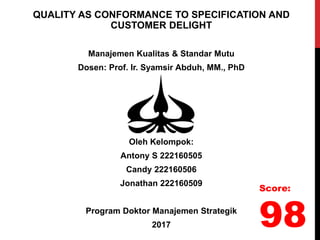Tugas 10 definisi kualitas
- 1. QUALITY AS CONFORMANCE TO SPECIFICATION AND CUSTOMER DELIGHT Manajemen Kualitas & Standar Mutu Dosen: Prof. Ir. Syamsir Abduh, MM., PhD Oleh Kelompok: Antony S 222160505 Candy 222160506 Jonathan 222160509 Program Doktor Manajemen Strategik 2017 Score: 98
- 2. 10 DEFINITIONS OF QUALITY SOURCES: 7 ARTICLES AND 3 BOOKS (2016-2017)
- 3. WHAT IS QUALITY? 1. Quality is the totality of features and characteristics of a product or service that bear on its ability to satisfy given needs (Alhassan, Alzahrani, & Aziz, 2017). 2. Quality is a set of properties and features that give the product or service the property to meet specific needs (Androniceanu, 2017). 3. Quality is features and attributes of goods and services that respond to implicit and explicit customer requirements (Aquilani et al, 2017). 4. Quality is defined as the fitness of product or service for its intended use and control conveys an idea about determining and maintaining of product and service (Aggarwal, 2016).
- 4. WHAT IS QUALITY? 5. Quality is defined as excellence, superiority, and an assurance that there are less defects in services or products (Alzhrani, Alotibie, & Abdulaziz, 2016). 6. Quality is the inspiration for human being to move from better to the best available options (Bhat, 2016). 7. Quality is the conformance to requirements and ability of a product or service to consistently meet or exceed customer expectations (Parthasarathi, Rao, & Reddy, 2016). 8. Quality is a mindset of inquiry and the capacity to use appropriate tools to improve systems in which we work (Sherwood & Barnsteiner, 2017).
- 5. WHAT IS QUALITY? 9. Quality is that characteristic we can feel and know when we have it, but we canât describe it advance (Barker & Milivojevich, 2016). 10. Quality may be defined is the fitness of that product or service for meeting or exceeding its intended use as required by the customer (Mitra, 2016).
- 6. WHAT IS QUALITY? - Quality is the conformance to requirement and ability of a product or service to consistently meet or exceed customer expectations (Parthasarathi, Rao, & Reddy, 2016).
- 7. REFERENCES Aggarwal, P. (2016). Total Quality Management and Teacher Education. International Journal of Applied Research, Vol.2 (1), 600-601. Alhassan, A., Alzahrani, W., & Aziz, A. A. (2017). Total Quality Management for Software Development. International Journal of Computer Applications, Vol.158, No.5, 38-44. Alzharani, K.M., Alotibie, B.A., & Abdulaziz, A. (2016). Total Quality Management in Saudi Higher Education. International Journal of Computer Applications, Vol.135, No.4, 6-12. Androniceanu, A. (2017). The Three-Dimensional Approach of Total Quality Management, An Essential Strategic Option For Business Excellence. Quality Management and Business Excellence, Vol.19, No.44, 61-78. Aquilani, B., Silvestri, C,., & Ruggieri, A. (2016). A Systematic Literature Review on Total Quality Management Critical Success Factors and The Identification of New Avenues of Research. The TQM Journal, Vol.29, (1), 184-213.
- 8. REFERENCES Barker, T.B., & Milivojevich, A. (2016). Quality By Experimental Design. London: CRC Press. Bhat, B.A. (2016). Teacherâ Perception Towards Total Quality Management in Secondary Schools. International Journal for Educational Studies, 9(1), 41-48. Mitra, A. (2016). Fundamentals of Quality Control and Improvement. New York: Wiley. Parthasarathi, S.K. Rao, K.V.S.R, and Reddy, P.N. (2016). Spiritual Leadership and its Contribution to Soft Dimensions of Total Quality Management: Relevance to Micro, Small and Medium Enterprises in India. Indian Journal of Science and Technology, Vol. 9(33), 1-15. Sherwood, G., & Barnsteiner, J. (2017). Quality and Safety in Nursing. Canada: Wiley Blackwell.








